Burnham ES2 User Manual

INSTALLATION, OPERATING AND
SERVICE INSTRUCTIONS FOR
ES2™
ENHANCED SERIES 2
Gas - Fired Boiler
As an ENERGY STAR® Partner, Burnham Hydronics has determined that this boiler meets the ENERGY
STAR® guidelines for energy efficiency established by the United States Environmental Protection Agency (EPA).
For service or repairs to boiler, call your heating contractor. When seeking information on boiler, provide Boiler Model Number and Serial Number as shown on Rating Label.
Boiler Model Number |
Boiler Serial Number |
Installation Date |
ES2 |
|
|
|
|
|
Heating Contractor |
|
Phone Number |
|
|
|
Address |
|
|
102538-01R4-2/10
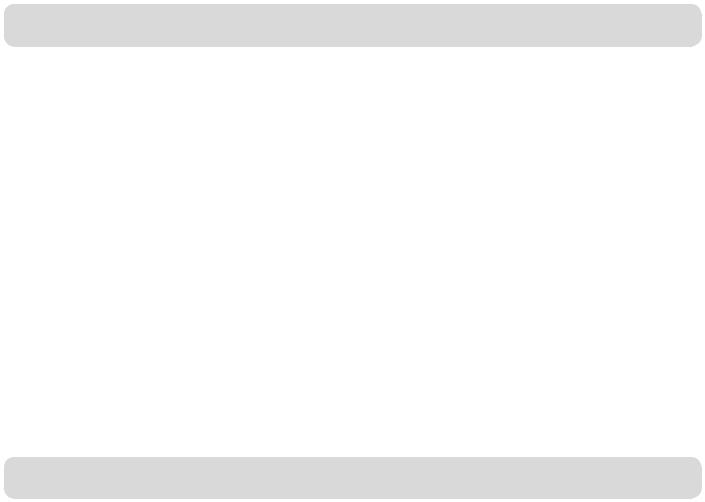
 WARNINGS for the HOMEOWNER
WARNINGS for the HOMEOWNER
FOLLOW ALL INSTRUCTIONS and warnings printed in this manual and posted on the boiler.
INSPECT THE BOILER ANNUALLY. To keep your boiler safe and efficient, have a service technician follow the Service checklist near the end of this manual.
IF YOU ARE NOT QUALIFIED to install or service boilers, do not install or service this one.
THE BOILER MAY LEAK WATER at the end of its useful life. Be sure to protect walls, carpets, and valuables from water that could leak from the boiler.
PROTECT YOUR HOME IN FREEZING WEATHER. A power outage, safety lockout, or component failure will prevent your boiler from lighting. In winter, your pipes may freeze and cause extensive property damage. If you must leave your home unattended for an extended time when
outdoor temperatures are below 32°F, first turn off your home’s main water supply and drain the water from all pipes.
DO NOT BLOCK AIR FLOW into or around the boiler. Insufficient air may cause the boiler to produce carbon monoxide or start a fire.
KEEP FLAMMABLE LIQUIDS AWAY from the boiler, including paint, solvents, and gasoline. The boiler may ignite the vapors from the liquids causing explosion or fire.
KEEP CHILDREN AND PETS away from hot surfaces of the boiler, boiler piping, and vent pipe.
CARBON MONOXIDE (CO) is an odorless, deadly gas that may be introduced into your home by any malfunctioning fuel-burning product or vent system failure. Consider installing CO alarms near bedrooms in all levels of the building to warn you and your family of potential CO exposure.
 WARNINGS for the INSTALLER
WARNINGS for the INSTALLER
READ THIS ENTIRE MANUAL before attempting installation, start-up, or service. Improper installation, adjustment, alteration, service, or maintenance may cause serious property damage, personal injury, or death.
DO NOT DISCONNECT PIPE FITTINGS on the boiler or in the heating system without first verifying that the system is cool and free of pressure and that your clothing will protect you from a release of hot water or steam. Do not rely solely on the boiler’s temperature and pressure gage when making this judgment.
USE PROPER PERSONAL PROTECTION EQUIPMENT when servicing or working near the boiler. Materials of construction, flue products, and fuel contain alumina, silica, heavy metals, carbon monoxide, nitrogen oxides, and/or other toxic or harmful substances that can are hazardous to health and life and that are known to the State of
California to cause cancer, birth defects, and other reproductive harm.
INSTALL ALL GUARDS, cover plates, and enclosures before operating the boiler.
SIZE THE BOILER PROPERLY relative to the design heat load or, if using domestic hot water priority, the peak hot water load, whichever
is larger. A grossly oversized boiler will cycle excessively and this will lead to premature failure of the boiler and its components. Our warranty does not apply to damage from excessive cycling.
ADHERE TO ALL LOCAL CODE REQUIREMENTS. Contact your local code inspector prior to installation. In the absence of a local code, adhere to the National Fuel Gas
Code ANSI Z223.1/NFPA 54 or CAN/CSA B149.1, Natural Gas and Propane Installation Code.
ALL WIRING must comply with the National
Electrical Code ANSI/NFPA 70 (in the USA) or the Canadian Electrical Code CSA C22.1 (in Canada) and any local regulations.

Congratulations on your purchase of a new Burnham® boiler—designed and constructed to provide you with years of reliable service.
•ENERGY STAR™ efficiency – friendly on the environment and your wallet.
•Cast iron heat exchanger – for reliability and durability, nothing beats a cast iron heat exchanger. Ours is made proudly by our foundry in Zanesville, Ohio.
•IQ Control™ – the most advanced and easiest to use control available.
•System-friendly – built-in protection from condensation and thermal shock.
|
What's in the crate? |
5. q Instruction Envelope (102625-01) |
||
1. |
q |
ES2™ Boiler |
q Instruction & Operation Manual |
|
|
(102538-01) |
|||
2. |
q |
Vent Damper w/ Carton |
q |
Hydronics Institute Instructions |
|
|
4” Damper ES23 (102284-01) |
|
(81460061) |
|
q Boiler Warranty Sheet (102198-01) |
|||
|
|
5” Damper ES24 (102284-02) |
||
|
q |
Equipment List (102620-01) |
||
|
|
6” Damper ES25 & ES26 (102284-03) |
||
|
|
|
||
|
7” Damper ES27 & ES28 (102284-04) |
|
5 |
|
|
8” Damper ES29 (102284-05) |
|
||
|
|
|
||
3. q Circulator & Gasket Kit |
|
|
||
|
Taco 007-2 (8056170) |
|
|
|
|
Grundfos UP-15 (8056173) |
|
|
|
|
B & G NRF-22 (8056174) |
|
|
|
4. |
q |
Miscellaneous Parts Bag (102627-01) |
|
1 |
|
|
|||
|
|
q Temperature/Pressure Gage; ¼” NPT |
|
|
|
|
(100282-01) |
|
|
qCirculator Mounting Hardware Kit, 1-
1/4” NPT (6056007) |
|
|
q Circulator Wiring Harness (6130701) |
|
|
q Drain Valve; ¾” NPT (806603012) |
|
|
q Pressure Relief Valve; 30 psi |
4 |
2 |
(81660363) |
|
|
|
|
|
q Water Manifold for Pressure Relief/ |
|
|
Temp. Gage (80607001) |
|
|
|
|
3 |

SPECIFICATIONS
Ratings
ES2 Series
Boiler Model |
Input (MBH) |
DOE Heating Capacity (MBH) |
Net I=B=R Rating (MBH) |
AFUE (%) |
ES23 |
70 |
59 |
51 |
85 |
ES24 |
105 |
88 |
77 |
85 |
ES25 |
140 |
118 |
102 |
85 |
ES26 |
175 |
147 |
128 |
85 |
ES27 |
210 |
176 |
153 |
85 |
ES28 |
245 |
206 |
179 |
85 |
ES29 |
280 |
235 |
205 |
85 |
Electrical Requirements: 120VAC, 60 Hz, 1-ph, 15A
Dimensions and Connections
Boiler |
Depth |
Width |
Height |
Supply NPT |
Return NPT |
Vent |
Gas NPT |
Relief Valve |
Drain |
Model |
|
|
|
(inch) |
(inch) |
(inch) |
(inch) |
NPT (inch) |
NPT (inch) |
ES23 |
33 |
12¾ |
41 |
1¼ |
1¼ |
4 |
½ |
¾ |
¾ |
ES24 |
33 |
15½ |
41 |
1¼ |
1¼ |
5 |
½ |
¾ |
¾ |
ES25 |
33 |
18½ |
41 |
1¼ |
1¼ |
6 |
½ |
¾ |
¾ |
ES26 |
33 |
21½ |
41 |
1¼ |
1¼ |
6 |
½ |
¾ |
¾ |
ES27 |
33 |
24¾ |
41 |
1¼ |
1¼ |
7 |
¾ |
¾ |
¾ |
ES28 |
33 |
27¾ |
41 |
1¼ |
1¼ |
7 |
¾ |
¾ |
¾ |
ES29 |
33 |
30¾ |
41 |
1¼ |
1¼ |
8 |
¾ |
¾ |
¾ |
Water Temperatures and Flows
Boiler Model |
Allowable Supply |
Minimum Return |
Minimum Flow |
Waterside Pressure Drop |
Water Temperature |
Water Temperature |
(GPM) |
at 20°F DT |
|
|
(°F) |
(°F) |
(Ft. of Head) |
|
|
|
|||
ES23 |
130-220 |
110 |
None |
<1 |
ES24 |
130-220 |
110 |
None |
<1 |
ES25 |
130-220 |
110 |
None |
<1 |
ES26 |
130-220 |
110 |
None |
<1 |
ES27 |
130-220 |
110 |
None |
<1 |
ES28 |
130-220 |
110 |
None |
<1 |
ES29 |
130-220 |
110 |
None |
<1 |
Weights and Volume
Boiler |
Shipping Weight |
Empty Weight |
Water Content |
Model |
(lbs) |
(lbs) |
(gal) |
ES23 |
250 |
170 |
2 |
ES24 |
300 |
220 |
3 |
ES25 |
350 |
270 |
4 |
ES26 |
410 |
320 |
5 |
ES27 |
460 |
370 |
5 |
ES28 |
510 |
420 |
6 |
ES29 |
560 |
470 |
7 |
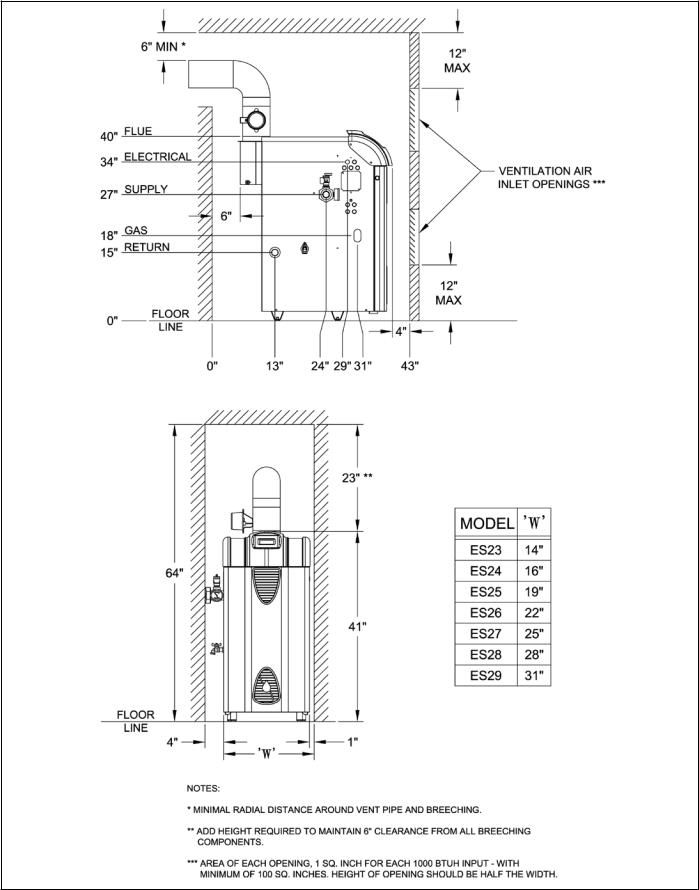
SPECIFICATIONS (continued)
Figure S-1: Minimum Clearances to Combustibles and Closet Dimensions

Boiler Quick-Start
Installation: |
|
|
1. |
Unpack the crate.............................................................................................. |
7 |
2. |
Position the boiler............................................................................................. |
7 |
3. |
Provide combustion air..................................................................................... |
8 |
4. |
Connect venting............................................................................................... |
8 |
5. |
Connect gas piping......................................................................................... |
10 |
6. |
Connect boiler water piping............................................................................ |
10 |
7. |
Connect electrical wiring................................................................................ |
12 |
8. |
Program the controls...................................................................................... |
13 |
9. |
Check for gas and water leaks....................................................................... |
15 |
10. |
Perform startup checks and adjustments....................................................... |
16 |
Annual Maintenance Checklist............................................................................ |
17 |
|
Troubleshooting.................................................................................................... |
18 |
|
Repair Parts List.................................................................................................... |
21 |
|
Internal Wiring....................................................................................................... |
27 |
|
Appendices: |
|
|
A – Combustion Air.................................................................................................. |
32 |
|
B – Venting............................................................................................................... |
33 |
|
C – Gas Piping......................................................................................................... |
36 |
|
D – System Piping.................................................................................................... |
37 |
|
E – Filling the System and Checking for Leaks........................................................ |
43 |
|
F – Adjusting Gas Input Rate................................................................................... |
44 |
|
G – Checking Draft and Combustion....................................................................... |
46 |
|
H – IQ Control System............................................................................................. |
47 |
|
Warranty................................................................................................... |
Back Cover |
|
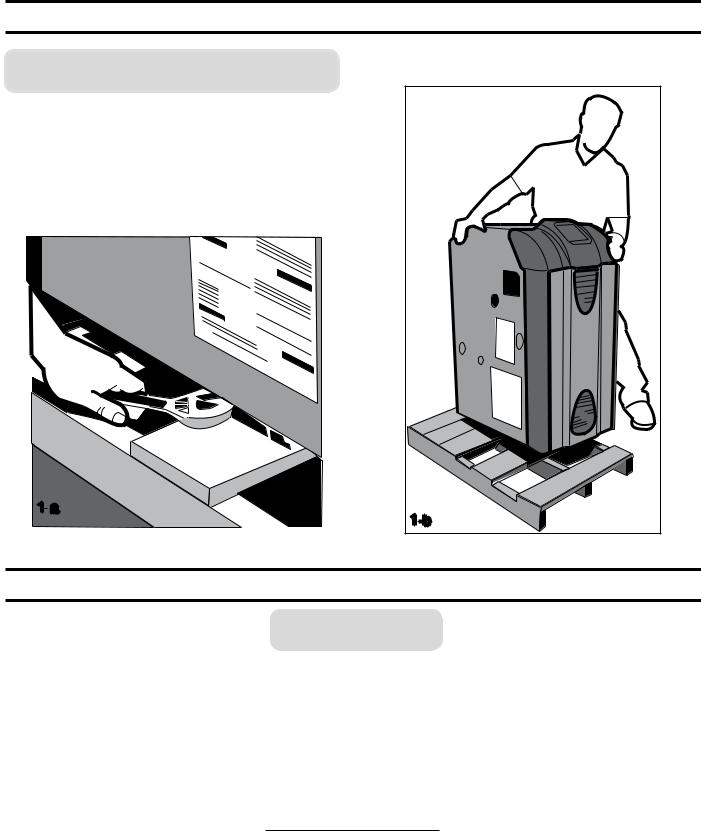
1. Unpack the Crate
THE BOILER IS TOP-HEAVY. Do not allow it to tip over.
1.Remove the sleeve.
2.Remove the contents from the skid, except the boiler.
3.Remove the four (4) hex-drive lag screws holding the boiler to the skid (Figure 1-a).
1- a
a
4. Tip the boiler and shimmy it off the skid.
1-b |
2. Position the Boiler
 WARNINGS
WARNINGS
OBSERVE MINIMUM CLEARANCES to combustible walls and ceilings to avoid potential fire hazard.
DO NOT INSTALL ON CARPET. This may cause a fire.
INSTALLING THE BOILER NEAR A SOURCE OF FLAMMABLE LIQUIDS or gases may cause fire or explosion.
CLEAN BURNERS DAILY if operating the boiler in a dusty environment.
PROTECT IGNITION SYSTEM COMPONENTS from sources of water that may spray, drip, or rain on them during installation or service.
1.Slide the boiler into desired location.
2.Meet the minimum clearances to combustible construction per the Specification Section of this manual.
3.Allow 24" service clearance in front and on the left side of the boiler.
4.Level the boiler, using shims as necessary.
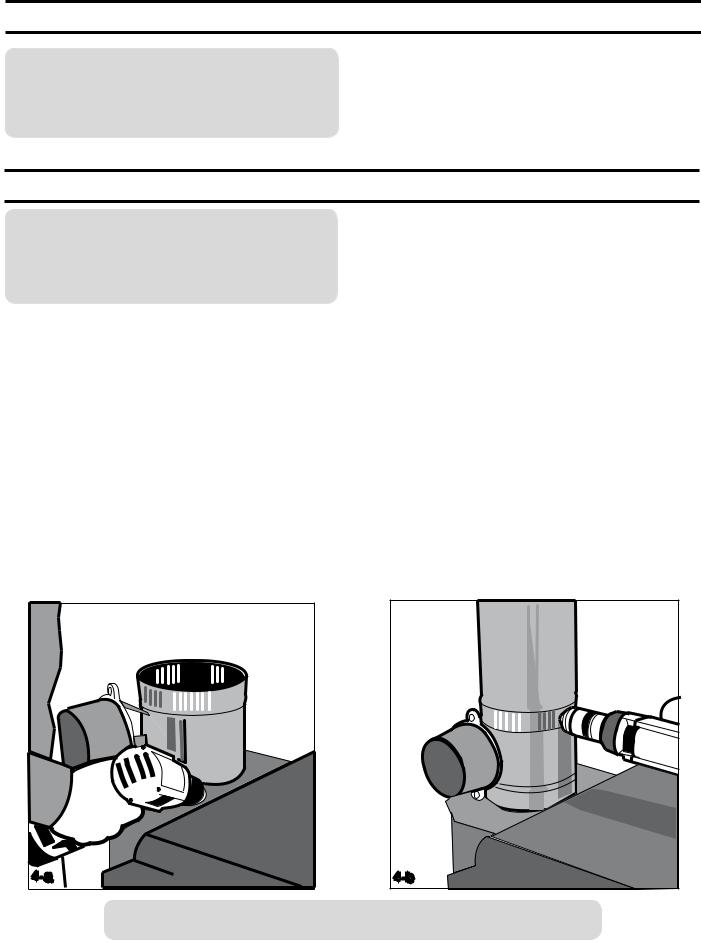
3. Provide Combustion Air
INSUFFICIENT COMBUSTION AIR
SUPPLY may result in the production and release of deadly carbon monoxide (CO) into the home which can cause severe personal injury or death.
Like all fuel-burning appliances, boilers need air to operate reliably and safely.
Provide combustion air using the instructions in
Appendix A—Combustion Air.
4. Connect Venting
IMPROPER VENTING may result in property damage and the release of flue
gases which contain deadly carbon monoxide (CO) into the home, which can cause severe personal injury, death or substantial property damage.
The vent system shall be designed and constructed in accordance with NFPA 54 and applicable local codes to develop a positive flow adequate to convey flue or vent gases to the outdoors, while ensuring that flue gases do not cool prematurely.
Observe all general venting guidelines provided in
Appendix B—Venting. Additionally:
1.This appliance shall be vented into a listed gas vent, masonry, metal, or factorybuilt chimney as required by NFPA 54 and applicable local codes for Category I appliances. If venting this appliance into a masonry chimney, the chimney must be lined with a listed chimney lining system
(i.e. Type B gas vent or flexible metal) as required by NFPA 54 and applicable local codes. Clay flue lined masonry chimneys do not meet the venting requirements for this appliance.
2.Attach the vent damper with three sheetmetal screws around the perimeter of the flue collar (Figure 4-a), oriented so that the position indicator is visible. The vent damper may also be mounted anywhere between the flue outlet and the chimney within reach of the electrical harness.
3.Vent connector shall be double-wall insulated gas vent as supplied with this boiler or Type B (double-wall) gas vent only. Using sheetmetal screws, attach the vent connector between the vent damper and the vertical chimney (Figure 4-b). Do not exceed the maximum vent connector length in Table 4.1.
4-a |
4-b |
 DAMPER MUST BE OPEN when the main burner is firing.
DAMPER MUST BE OPEN when the main burner is firing.

4. Connect Venting (continued)
Table 4.1: ES2 Vent Connector - Horizontal Length Restrictions (ft)
Model |
ES23 |
ES24 |
ES25 |
ES26 |
ES27 |
ES28 |
ES29 |
|
Input (MBH) |
70 |
105 |
140 |
175 |
210 |
245 |
280 |
|
Minimum Vent |
4 |
5 |
6 |
6 |
7 |
7 |
8 |
|
Diameter (in) |
||||||||
|
|
|
|
|
|
|
||
Vent Height (ft) |
|
|
With B-Vent (double wall) Vent Connector |
|
|
|||
6 |
0 |
0 |
6 |
0 |
4 |
0 |
2 |
|
8 |
8 |
8 |
8 |
2 |
8 |
2 |
8 |
|
10 |
10 |
10 |
10 |
10 |
10 |
10 |
10 |
|
15 |
15 |
15 |
15 |
15 |
15 |
15 |
15 |
|
20 |
20 |
20 |
20 |
20 |
20 |
20 |
20 |
|
30 |
20 |
30 |
30 |
30 |
30 |
30 |
30 |
|
50 |
20 |
30 |
30 |
30 |
30 |
30 |
30 |
|
100 |
20 |
30 |
30 |
30 |
50 |
50 |
50 |
|

5. Connect Gas Piping
Size gas piping according to Appendix C – Gas Piping
SHUT OFF GAS SUPPLY before servicing the boiler.
ALL GAS PIPING MUST BE GAS
TIGHT. Use gas rated thread compound on all threaded joints to avoid leaks, which may result in fire or explosion.
SIZE GAS PIPING, regulators, valves, and meters so as to provide an adequate
gas flow and pressure to the boiler during operation. Failure to do so may cause poor combustion, noise, injury, or death.
1.Remove boiler door, locate gas valve and remove plastic shipping plug.
2.Thread a ¾" x 1½" nipple, a 90° street elbow, or a Honeywell flange onto the gas valve and pipe through the slot in the left jacket panel (Figure 5-a). In Canada, close
nipples and street ells are not approved for use as gas piping.
3.Pipe through the left jacket panel, and complete drip leg as shown (Figure 5-a).
5-a |
6. Connect Boiler Water Piping
General system piping guidelines are included in
Appendix D—System Piping.
Additionally, for this particular boiler install piping shown below (Figure 6-a).
|
RV |
|
O |
S |
|
R |
G |
|
D |
6-a |
|
1. Apply sealant to all threads.
2.Screw the water supply manifold into the boiler outlet tapping “O.”
3.Orient the manifold with the relief valve on top.
4.Screw the relief valve into manifold tapping “RV”.
iThis installation is not complete until the relief valve is installed.
PIPE THE RELIEF VALVE DISCHARGE to a location where it will not harm
people or damage property. The relief valve may discharge scalding hot water or steam.
BLOCKING THE RELIEF VALVE may result in boiler explosion.
5.Screw the temperature-pressure gage into manifold tapping “G”.
6.Connect the system supply to the open end of the manifold "S" using a 1¼” male NPT fitting.
10
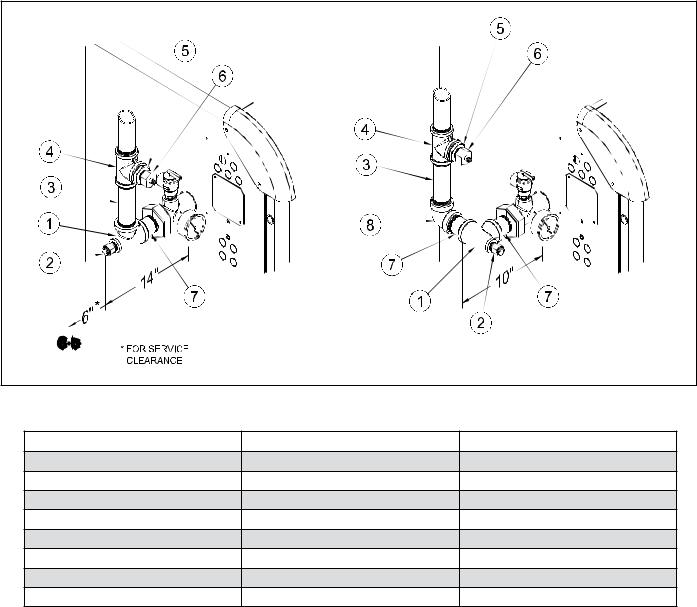
6. Connect Boiler Water Piping (continued)
7.Screw an installer-supplied 1¼” pipe or nipple into the water return tapping “R”.
8.Screw the supplied drain valve into tapping “D”.
9.See Figure 6b for suggested near boiler piping of IQ Options.
6-b |
|
|
Item |
Description |
Burnham Part Number |
1 |
1¼ x 1¼ x ½ Tee |
806601021 |
2 |
Immersion Well, ½ NPT |
80160456 |
3 |
1¼ x 6 Nipple |
806600029 |
4 |
1¼ Tee |
806601030 |
5 |
1¼ x ¾ Bushing |
806600504 |
6 |
LWCO Sensor, ¾ NPT |
102305-01 |
7 |
1¼ x 3 Nipple |
806600005 |
8 |
1¼ Elbow |
806601528 |
|
|
11 |
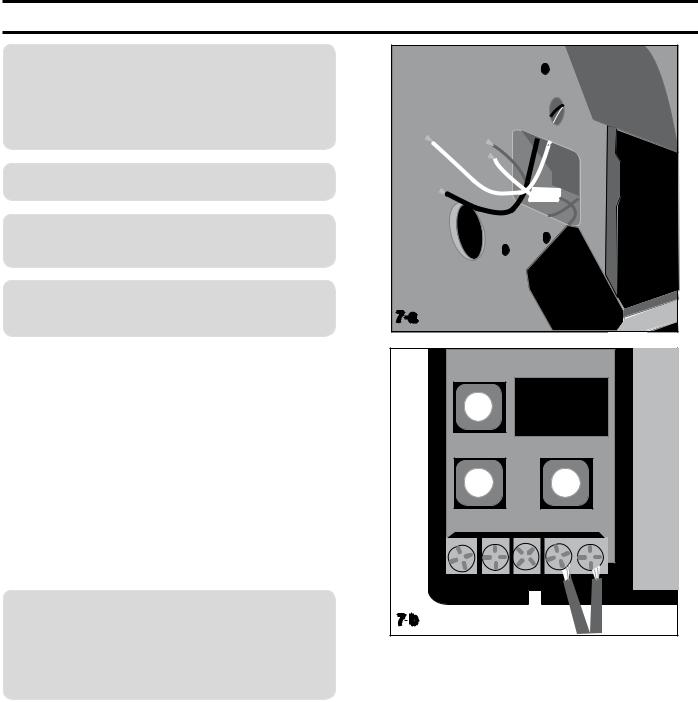
7. Connect Electrical Wiring
DISCONNECT ELECTRICAL POWER to the boiler and heating system before
servicing. Positively assure that no voltage is present. Lock electrical boxes to prevent someone from inadvertently restoring power before the heating system is safe to operate.
NEVER DEFEAT OR JUMP OUT safety devices.
PROTECT EACH BOILER circuit with a properly sized over-current protection
device.
MAKE ELECTRICAL CONNECTIONS
CAREFULLY according to the boiler’s wiring diagram and instructions
Refer to the Internal Wiring diagrams later in this manual.
1.Locate the wiring box on the left side of the boiler and open the cover (Figure 7-a).
2.Install a 120V disconnect near the boiler.
3.Connect the 120V wiring from the disconnect to the boiler's white (neutral), black (hot), and green (ground) labeled "120VAC Power supply". Do not reverse polarity.
4.Connect the 120V wiring from the circulator to the white (neutral) yellow (hot) wires marked "circulator".
WIRE AN ADDITIONAL SAFETY LIMIT such as a low water cutoff or temperature
limit device, other than an IQ™ Control device, in series with the 120V circuit used to power the boiler. Do not alter the boiler’s factory wiring when adding an additional limit.
7-a |
|
|
|
|
|
1 |
2 |
3 T T |
7- b
b
5.Connect the 24V wiring from the thermostat to the "T-T" terminals on the Option Control
Panel.
6.To connect other external devices, refer to the instructions included with these devices.
12

8. Program the Controls
Using IQ Boiler Control Display
The IQ Boiler Control is located inside the boiler front door, just above the IQ Option Panel (Figure 8-a).
IQ Boiler Control |
IQ Option Panel |
8-a |
The IQ Boiler Control display, along with Up ñ, Down ò, and “I” keys may be used to view boiler operating status (Figure 8-b). Please note that these keys look similar to the keys on the IQ
Option Panel but are in a different orientation, and they perform different functions.
|
ñ |
I |
ò |
IQ Boiler Control
8- b
b
Viewing the Operating Mode Options
In operating mode the user may view (but not change) boiler operating status, settings and troubleshooting information. To view IQ Boiler
Control display information:
1. Press and release the “I” key on the IQ Boiler Control to change from one parameter to the next. Each setting will alternately flash between the relevant display code and its corresponding value.
Operating Mode Options
StA Status
bt Boiler Temperature
SP Operating Setpoint (Outdoor Reset)
HL High Limit Setting HdF High Limit Differential hr Heat Request Status FLA Flame Current
rUn Run Time Hours CYC Boiler Cycles
Err Error (see Error Numbers)
Status Code Displayed in STA Mode
1Standby:
Either TT Open or TT Closed and Boiler Temperature within Setpoint & Differential with circulator running.
4 Prepurge
6Spark
7Flame Proving
8Running
10 Retry/Recycle Delay
13Soft Lockout
14Hard Lockout
15Waiting for Limit to Close
16Flame Present Out of Sequence
17Self Test
18Waiting for Damper to Open
19Waiting for Damper to Close
20Damper Failure to Open
21Damper Failure to Close
For example, when the “I” key is pressed on the IQ Boiler Control until “bt” is displayed, it will then flash a three digit number (such as “180”) followed by either “F” (or “C”). This indicates that the boiler water temperature is 180°F. Other operating parameters display the information in a similar fashion.
13
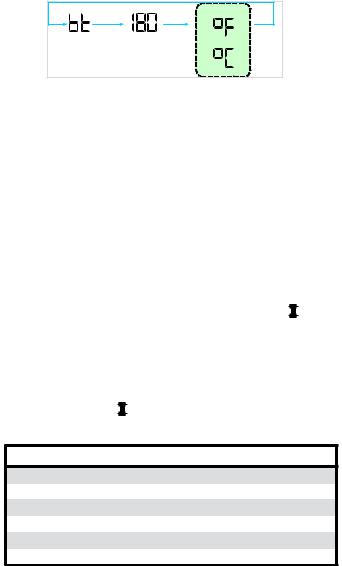
8. Program the Controls (continued)
1 sec |
1 sec |
Unit Display |
|
||
|
|
1 sec |
Sample |
|
OR |
|
|
|
Display |
|
|
Please note that in operating mode to hold the display on the value the user can press and hold either the Up ñ or Down ò keys and the value will be continuously shown. This may be helpful in watching a value “live”.
Changing the Adjustable Parameters
To adjust the High Limit setpoint, High Limit Differential or Pump Overrun time settings or setting the display for either °F or °C temperature readings:
1.Access the adjustment mode by pressing and holding the Up , Down , and “I” keys simultaneously for three (3) seconds. This procedure is intended to discourage unauthorized changes or accidental changes to limit settings.
2.Press the "I" key to display available Adjustment Mode options. Select an option.
Adjustment Mode Options
HL_ Adjust High Limit Setting dF_ Adjust High Limit Differential
Or_ Pump Overrun Time (minutes) rst Reset Lockout
f-C Select degrees F or C Mode bac Back to Operating Mode
3.Press the Up and Down keys to adjust the displayed setpoint to the desired value.
4.To return to the normal operating mode from the Adjustment Mode, when the "bAc” option is displayed, press either the Up ñ or Down ò key. If no keys are pressed, after five (5) minutes the IQ Boiler Control will automatically return to the Operating Mode.
More Information about Adjustable Parameters
1.High Limit (HL_)
The IQ Control is factory programmed
with a High Limit Setpoint of 180°F. The boiler turns "off" when the supply water temperature is above this value. The High Limit setpoint is adjustable between 130° and 220°F. The Operating Setpoint (SP) will equal the High Limit Setpoint unless an IQ
Outdoor Reset IQ Option Card is installed.
The Outdoor Reset IQ Option Card reduces the Operating Setpoint to regulate heat delivery, increase home comfort and
save energy. Refer to the Appendix H for additional information.
2.Differential (df_)
The IQ Boiler Control is factory programmed with a Differential of 15°F. The Differential is the number of degrees the supply temperature must decrease below the Operating Setpoint before the boiler can restart. The differential is adjustable between 10° through 30°F.
3.Pump Overrun Time (OR_)
The IQ Boiler Control is factory programmed with a Pump Overrun Time of 0 minutes. Pump Overrun Time (also called “off delay” or “post purge”) continues pump operation after a call for heat has ended, sending excess heat from the boiler into the priority zone. Ensure system piping and zone panel settings allow water flow to the priority zone after the call for heat ends. The Pump Overrun Time is adjustable between 0 through 10 minutes.
Using the IQ Option Panel
IQ Option Cards are available from Burnham distributors and are the simplest way to add functionality, safety and efficiency to your heating system. The IQ Option Panel provides an easy and convenient means to "plug-in" an Auxiliary High Limit, Low Water Cut-off and/or Outdoor Reset function.
For installation, programming, and troubleshooting instructions, refer to the instructions supplied with those cards.
14

8. Program the Controls (continued)
Using the Optional LCD Display Kit
The LCD Display is an easy to use touch screen type display that allows a technician to monitor and adjust the IQ Boiler Control and connected IQ Option Cards. All boiler settings, status and error codes are displayed in full text. All Outdoor Reset IQ Option Card parameters are adjustable
with graphic and help information screens. The LCD Display Kit includes a mounting bracket and wiring harness to allow mounting in the ES2 plastic hood above the front door. For installation, programming, and troubleshooting instructions, refer to the instructions supplied with the display.
9. Check for Gas and Water Leaks
GAS LEAKS may result in fire or explosion.
WATER LEAKS may cause extensive property damage.
Refer to Appendix E – Filling the System and Checking for Leaks
15
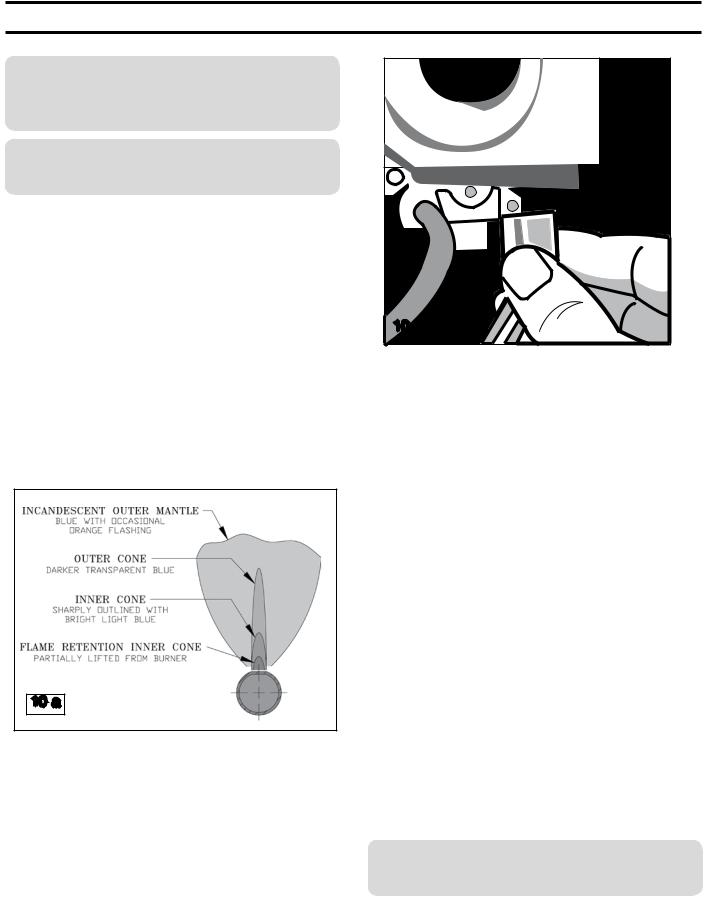
10. Perform Startup Checks and Adjustments
FAILURE TO PERFORM THESE
CHECKS of the boiler's combustion and safety systems may result in serious property damage, injury, or death.
IF YOU SMELL GAS, STOP and repair the leak. Lighting the boiler when gas is
leaking may cause explosion or fire.
Follow the checklist below:
1.Verify that the venting, water piping, gas piping, and electrical systems are properly installed and checked.
2.Apply power to the boiler.
3.Adjust zone thermostat to maximum setting.
4.Allow gas line to purge of air.
q Boiler lights cleanly within 60 seconds.
5.Adjust gas input rate. See Appendix F
– Adjusting Gas Input Rate
10- a
a
qPilot and main burner flames appear clean and blue.
6.Disconnect pilot lead wires from gas valve (Figure 10-b).
qBoiler shuts off.
7.Reconnect pilot lead wires to gas valve.
qBoiler restarts.
10-b |
8.Adjust zone thermostat to minimum setting. q Boiler shuts off.
9.Adjust zone thermostat to maximum setting.
10.Observe temperature gage as boiler heats.
11.Adjust the high limit setting to its minimum level (see "Programming High Limit" in Section 8).
qBoiler shuts off when temperature gage reads within 15°F of high limit setting.
12.Return high limit to the desired setting (see
"Programming High Limit" in Section 8).
13.Check draft. See Appendix G
–Checking Draft and Combustion.
qNo spillage observed.
14.Check combustion in the vent stack and record results in the spaces provided below.
_____ |
CO2 |
(less than 7%) |
_____ |
O2 |
(more than 9%) |
_____ |
CO |
(less than 100 ppm, air free) |
ANY FAILED STARTUP CHECK
Must be corrected before placing the boiler in service.
16
